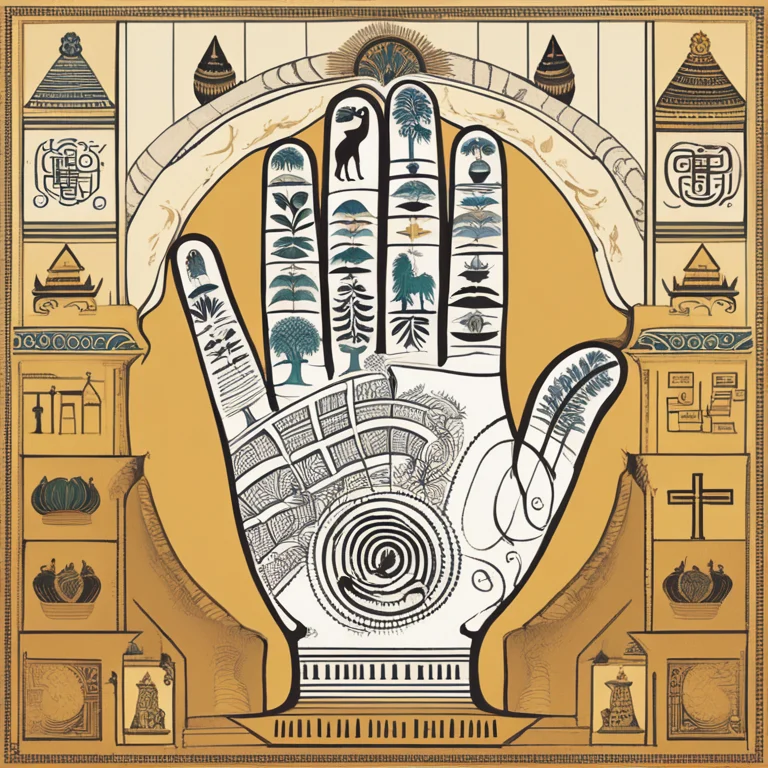
The Truth Behind Palmistry's Power
Discover the intriguing art of palmistry, its historical roots, and how it purports to reveal personality traits and future prospects through the analysis of hand features.
article by Nora Pennington
What is Palmistry?
Palmistry, also known as chiromancy or chirosophy, is the practice of interpreting a person's character and divining their future life by examining the palms of their hands. Dating back thousands of years, palmistry has been a tool for guidance in cultures around the world. The practice is rooted in the belief that the palms act as a unique reflector of both an individual's personality and potential life path. With the rise of psychological and spiritual wellness in 2024 and beyond, palmistry experiences a resurgence as an introspective art form.

Palmistry's Historical Significance
The historical significance of palmistry cannot be overstated. From ancient India, China, and Egypt to Greek and Roman philosophers like Aristotle who documented its practice, palmistry has woven its narrative across civilizations. In the digital age, it bridges the gap between traditional mysticism and contemporary spiritual hobbies, thriving alongside astrology and numerology in the modern quest for self-understanding and preemptive insights into one's destiny.

Analyzing the Palm
In palmistry, the analysis begins with the major lines on the palm: the heart line, head line, life line, and fate line. Each of these is believed to signify aspects such as emotional stability, intellectual capacity, life vitality, and the impact of outside forces on one's life events. The lines' qualities, such as their length, depth, and curvature, are meticulously studied to draw conclusions about individual life experiences and traits. With advanced scanning and software technologies in 2024, enthusiasts also use apps to capture and analyze their palm features accurately.
Hand Shapes and What They Tell
Beyond the lines, the hand itself speaks volumes. Palmists look at the shape of the hand—be it square, conical, spatulate, or pointed—as it is thought to offer additional insights into a person's temperament and approach to life. Moreover, finger lengths, the presence of markings like crosses, stars, islands, and the texture of the skin are considered in nuanced palm analysis, providing a comprehensive reading that caters to the growing individualistic sensibilities of the modern era.
The Skepticism and Science
Despite its popularity, palmistry is still met with skepticism. Critics argue that it lacks empirical evidence and scientific backing. Yet, palmistry's purpose is not rooted in empirical science but rather in symbolism and intuitive interpretation. With the expanding field of psychological studies touching upon embodied cognition and nonverbal communication in 2024, some studies suggest that our hands do indeed reveal aspects of our psychology and health, offering a glimmer of validation for what palmists have long asserted.
Embracing Palmistry Today
As individuals seek personal growth and understanding, palmistry caters to this inner quest for answers, providing insights and spurring introspection. Modern palmists combine traditional knowledge with psychological theories, aiming to empower clients with self-awareness rather than deterministic predictions. This contemporary approach to palmistry resonates with the values of the modern spiritual seeker who views such practices as tools for mindfulness and self-improvement.
Published: 1/11/2024
Modified: 1/11/2024
More predictions
Come back here soon to learn more about yourself and your future


The Basics of Palm Reading: A Beginner's Guide
Discover the basics of palm reading in this comprehensive guide aimed at beginners interested in the ancient practice of palmistry.


The Impact of the Jupiter Mount in Palmistry
Discover the impact of the Jupiter Mount on your life through palm reading. Learn about its meaning and significance in palmistry.